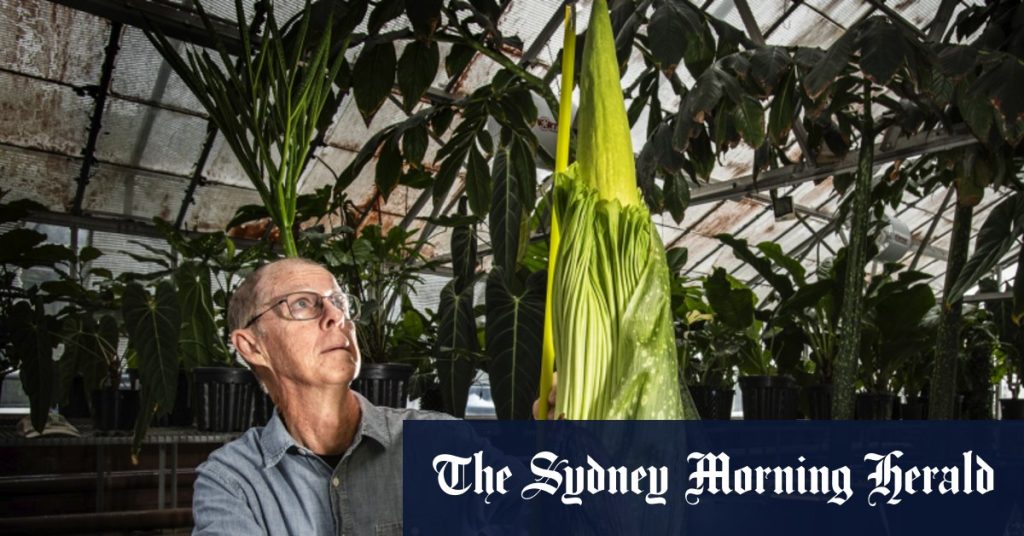The recent blossoming of a corpse flower at the Royal Botanic Garden Sydney marks another in a series of rare inflorescence events across Australia, highlighting the captivating nature of this unusual plant. This particular bloom follows closely on the heels of another corpse flower, nicknamed Casper, that reached full glory in Melbourne’s south-east, and a previous spectacle at the Geelong Botanic Gardens which drew over 20,000 onlookers. The Sydney event represents not only a unique opportunity for public viewing, but also underscores the Botanic Garden’s decades-long commitment to the conservation of this endangered species, a vital endeavor given its threatened status in its native Indonesia due to habitat destruction and poaching.
The corpse flower, despite its macabre moniker, boasts an even more intriguing scientific name, Amorphophallus titanum, translating to "giant deformed penis." This rather descriptive name refers to the plant’s unique structure, which houses both male and female reproductive organs, contributing to its infamous odor, often likened to rotting flesh. This pungent aroma is no accident; it’s a crucial evolutionary adaptation designed to attract specific pollinators, such as carrion beetles and flies, that are typically drawn to decaying matter. The potent scent effectively lures these insects into the flower’s depths, facilitating pollination and ensuring the continuation of the species.
The significance of the corpse flower extends beyond its bizarre appearance and olfactory assault. It serves as a prime example of the intricate ways in which plants have evolved to thrive in diverse environments and interact with their specific pollinators. Dr. Brett Summerell, Director of Research and Chief Botanist at the Royal Botanic Garden Sydney, emphasizes the plant’s clever adaptations, highlighting its ability to not just survive, but flourish in its niche environment. The corpse flower’s unusual pollination strategy, its imposing size, and its infrequent blooming cycle all contribute to its fascinating biology and underscore the complex interplay between plants and their surroundings.
The unpredictability of the corpse flower’s bloom adds to its mystique. Just as the timing of death is uncertain, the exact moment when the flower will unfurl its massive inflorescence remains elusive. However, once the bloom commences, the Royal Botanic Garden Sydney extends its hours, allowing the public to witness this rare event, often remaining open until midnight. Access is granted through donation, making the experience accessible to a wider audience. For those unable to attend in person, perhaps due to health concerns or a sensitivity to the flower’s powerful scent, a 24-hour live stream on YouTube provides a virtual window into the unfolding metamorphosis of this botanical wonder.
The Royal Botanic Garden Sydney’s conservation efforts related to the corpse flower play a crucial role in the species’ survival. The plant faces significant threats in its native Sumatra, including habitat loss due to deforestation for palm oil plantations and illegal collection for the horticultural trade. By cultivating and studying these plants, botanic gardens contribute to ex-situ conservation, safeguarding genetic diversity and raising awareness about the importance of protecting endangered species. The public’s fascination with the corpse flower provides a valuable opportunity to educate people about the plant’s unique biology, its conservation status, and the broader importance of biodiversity preservation.
The successive blooms of corpse flowers across Australia serve as a reminder of the wonders of the plant kingdom and the importance of scientific institutions like botanic gardens in preserving and showcasing plant diversity. These events offer a unique opportunity for public engagement with science and conservation, fostering appreciation for the intricacies of plant life and the challenges facing endangered species. The corpse flower’s peculiar beauty and pungent aroma, combined with its rarity, continue to captivate and educate, ensuring that this botanical oddity remains a subject of fascination and a symbol of the importance of plant conservation.

